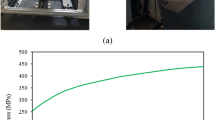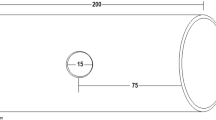Abstract
This paper investigates the collapse characteristics of CF/Epoxy composite tubes subjected to axial loads as changing interlaminar number and outer ply orientation angle. The tubes are aften used for automobiles, aerospace vehicles, trains, ships, and elevators. We have performed static and dynamic impact collapse tests by a way of building impact test machine with vertical air-compression. It is fanad that CF/Epoxy tube of the 6 interlaminar number (C-type) with 90° outer orientation angle and trigger absorbed more energy than the other tubes (A, B and D types). Also collapse mode depended upon outer orientation angle of CF/Epoxy tubes and loading type as well ; typical collapse modes of CF/Epoxy tubes are wedged, splayed and fragmentcl.
Similar content being viewed by others
References
Fairfull, A. H. and Hull, D., 1989, “Energy Absorption of Polymer Matrix Composite Structures: Frictional Effects,” In:Structural Failure, Edted by T. Wierzbicki and N. Jones, New York: Willey, pp. 255–279.
Farley, G. L. and Jones, RM., 1991, “The Effects of Crushing Speed on the Energy-Absorption Capability of Composite Tubes,”Journal of Composite Materials, Vol. 25, pp. 1314–1329.
Farley, G. L. and Jones, R. M., 1992, “Crushing Characteristics of Continuous Fiber-Reinforced Composite Tubes,”Journal of Composite Materials, Vol. 25(1), pp. 37–50
Farley, G. L. and Jones, R. M., 1992, “Prediction of the Energy-Absorption Capability of Composite Tubes,“Journal of Composite Materials, Vol. 25(3), pp. 388–404.
Gupta, N. K., Velmurugan, R. and Gupta, S. K., 1997, “An Analysis of Axial Crushing of Composite Tubes,”Journal of Composite Materials, Vol. 31, pp. 1252–1285.
Hamada, H., Ramakrishna, S., Nakamura, M. and Maekawa., Z., 1994, “Comparison of Static and Impact Energy Absorption of Glass Cloth/ Epoxy Composite Tubes,“Proceedings of the 10th Annual ASM/ESD Advanced Composite Conference, pp. 501,–510.
Kim, Y. N., Choi. H. S., Cha, C. S., Im, K. H., Jung, J. A. and Yang, I. Y., 2000, “Influence of Stacking Sequence Conditions on the Characteristics of Impact Collapse using CFRP Thin-Wall Structures,”KSME Journal A, Vol. 24, No. 12, pp. 2945–2951.
Kim, Y. N., 1m, K. H., Park, J. W. and Yang, I. Y., 2000, “Experimental Approach on the Colapse Mechanism of CFRP Composite Tubes,”Rewiews of Progress in QNDE, pp. 359,–375.
Tashiro, S., Yokoyama, A. and Hamada, H., 1998, “Numerical Method of Impact Deformation and Failure in Composite Tubes,”JSMS Composites-27, pp. 297–298.
Thornton, P. H. and Edwards, P. J., 1982, “Energy Absorption in Composite Tubes,“Journal of Composite Materials, Vol. 15, pp. 521–545.
Thornton, P. H., 1979, “Energy Absorption in Composite Structrues,”Journal of Composite Materials, Vol. 13, pp. 247–253.
Author information
Authors and Affiliations
Corresponding author
Rights and permissions
About this article
Cite this article
Kim, Y.N., Hwang, J.J., Baek, K.Y. et al. Impact collapse characteristics of CF/Epoxy composite tubes for light-weights. KSME International Journal 17, 48–56 (2003). https://doi.org/10.1007/BF02984285
Received:
Revised:
Published:
Issue Date:
DOI: https://doi.org/10.1007/BF02984285




